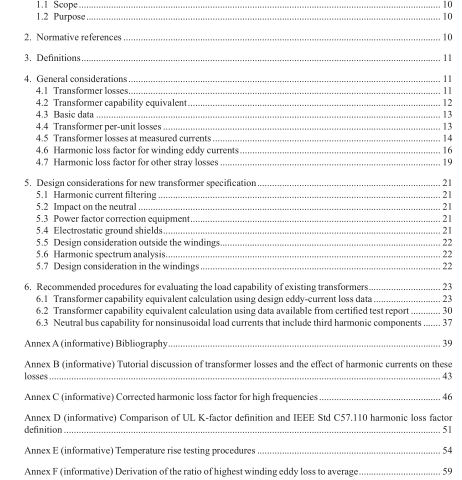IEEE C57.110-2018 pdf download.IEEE Recommended Practice for Establishing Liquid Immersed and Dry-Type Power and Distribution Transformer Capability when Supplying Nonsinusoidal Load Currents
4.1.1 Harmonic current efect on I 2 R loss If the rms value of the load current is increased due to harmonic components, the I 2 R loss will be increased accordingly.
4.1.2 Harmonic current efect on winding eddy-current loss Winding eddy-current loss (P EC ) in the frequency range under consideration (power frequency and associated harmonics) tends to be proportional to the square of the load current and approximately proportional to the square of frequency (see Crepaz [B8], Blume et al. [B6], Dwight [B11], as well as Bishop and Gilker [B5]). 7 It is this characteristic that can cause excessive winding loss and hence abnormal winding temperature rise and hottest spot temperatures in transformers supplying nonsinusoidal load currents.
4.1.3 Harmonic current efect on other stray loss It is recognized that other stray loss (P OSL ) in the core, clamps, and structural parts will also increase at a rate proportional to the square of the load current. However, these losses will not increase at a rate proportional to the square of the frequency, as in the winding eddy losses. Studies by manufacturers and other researchers have shown that the eddy-current losses in bus bars, connections, and structural parts increase by a harmonic exponent factor of 0.8 or less. Therefore, as a conservative estimate, an exponent of 0.8 will be used throughout this document. 8 The efects of these losses will also vary depending on the type of transformer. For example, the temperature rise in these non-winding parts will generally not be very critical for dry-type transformers. However, these losses must be properly accounted for in liquid immersed transformers, since they contribute to additional heating of the insulating liquid and the hottest spots in the structural parts.
4.1.4 DC components of load current Harmonic load currents are frequently accompanied by a dc component in the load current. A small dc component of load current will increase the transformer core loss slightly, but it will increase the magnetizing current and audible sound level more substantially. Relatively small dc components (up to the rms magnitude of the transformer excitation current at rated voltage) are expected to have no efect on the load carrying capability of a transformer determined by this recommended practice. Higher dc load current components may adversely afect transformer capability; possibly causing core saturation, core heating and unusual leakage fux patterns accompanied by unusual stray loss efects and should be avoided or otherwise accounted for.
4.1.5 Efect on top-liquid rise For liquid immersed transformers, the top-liquid rise (θ TO ) will increase as the total load losses increase due to harmonic loading. Unlike dry-type transformers, the other stray loss (P OSL ) must be considered, since these losses also afect the top-liquid rise.
4.2 Transformer capability equivalent The transformer capability established by following the procedures in this recommended practice is based on the following premises: a) The transformer, except for the load harmonic current spectrum, is presumed to be operated in accordance with Usual Service Conditions in IEEE Std C57.12.00 or IEEE Std C57.12.01
b) The transformer is presumed to be capable of supplying a load current of any harmonic content provided that the total load loss, the load loss in each winding, and the loss density in the region of the highest eddy-current loss do not exceed the levels for full load, rated frequency, and sine wave design conditions. It is also presumed that the limiting condition is the loss density in the region of highest winding eddy-current loss; hence, this is the basis used for establishing capability equivalency.IEEE C57.110 pdf download.IEEE C57.110-2018 pdf download
IEEE C57.110-2018 pdf download

Leave a Reply